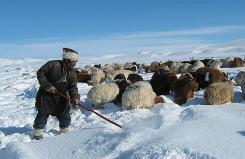Энэ 7 хоногт
Winter in Mongolia is ’an unfolding disaster’
BEIJING — When even Mongolians complain, you know it’s cold.

By Calum MacLeod, USA TODAY
BEIJING — When even Mongolians complain, you know it's cold.
As Americans shiver through lower than average temperatures this winter, the people of Mongolia and the animals they rely on suffer from temperatures that are extreme even by their standards.
Officials in Ulaanbaatar, the snowbound capital, have declared disaster status in more than half of Mongolia's 21 provinces, and more are set to follow across the vast, sparsely populated nation, roughly the size of Alaska.
After weeks of heavy snowfalls, fierce winds and temperatures as low as minus-58 degrees, 2.3 million livestock have perished and an additional 3 million may die by spring, according to the Mongolian government.
Mongolians use the term "dzud" for the combination of summer drought and severe winter that has hardened snow and ice into an impenetrable layer and makes it impossible for livestock to feed.
"The snow and cold are the worst I have ever seen," surpassing the last major dzud in 2000-2001, says Nyamaa Delegnyam, 48, foreign relations officer for the Khovd province in western Mongolia.
The human cost among Mongolia's population of 3 million remains difficult to quantify because of inaccessibility and limited communication. But infant mortality in the 12 hardest-hit provinces jumped by up to 60% in January compared with the previous five-year average, says Rana Flowers, Mongolia representative for the United Nations Children's Fund.
"This is an unfolding emergency, and we won't see the worst of it until further into spring," she says.
Though the focus is on aid, the disaster has recharged a long-running debate over the country's reliance on livestock herding, which accounts for up to 40% of all employment. Mongolia's 46 million head of livestock overgraze, but there is little agreement on how better to manage a nomadic lifestyle that defines the national psyche.
"Too many people have been involved in herding, which has resulted in massive exploitation of pastureland that can't cope with the huge numbers," says Akbar Usmani, Mongolia representative for the U.N. Development Program. Mongolia "needs quality not quantity, but that needs a mindset change that requires a lot of effort and support."
With official encouragement, livestock herds, notably cashmere-producing goats, have sharply increased since the country shed Soviet control two decades ago, says conservationist Batbold Dorjgurhem, director of international cooperation at the Ministry of Nature, Environment and Tourism.
"Many people recognize the problem, but when it comes to the solutions, there are many, many disputes," says Batbold, who blames overgrazing for depleting pastureland. Although the constitution defines pastureland as free, public land, "there should be a price to be paid for its use," Batbold says.
It may take weeks to get to the worst-affected areas, given the snow and underdeveloped road network. Even close to the provincial capital, "there are many, many dead animals everywhere," Nyamaa says.
To prevent disease outbreaks as warmer weather arrives, burial of dead livestock is a priority for the U.N. Development Program, Usmani says.
The U.N. will soon launch an emergency '"flash appeal" for Mongolia, he says, similar to its Haiti earthquake response, in addition to a UNICEF appeal, for 750,000usd , launched earlier this month.
Another problem that could follow is mass-migration. After the last dzud, many nomads abandoned the grassland to look for work in poor, urban fringes. "The great fear at the moment is that this will happen again, in greater numbers, and the cities cannot support them," Flowers says.
In Khovd, one of Mongolia's poorest areas, Nyamaa doubts many herders will switch livelihoods.
Worse may be yet to come at winter's end. "When the snow melts, it is 'dzud 2,' a flood like an ocean, which is a very big problem for gers [yurts used by nomads] and animals," Nyamaa says.





Зочин